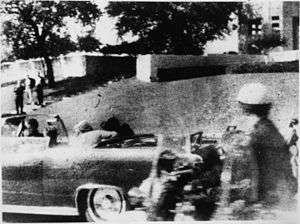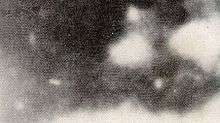Badge Man


Badge Man is the name given to an unknown figure reputedly visible within the famous Mary Moorman photograph of the assassination of U.S. President John F. Kennedy. Some researchers have theorized that this figure is an assassin firing a weapon at the President from the area of the grassy knoll in Dealey Plaza. An alleged muzzle flash obscures much of the detail, but "Badge Man" has nonetheless been described as a person wearing some kind of police uniform – the moniker itself derives from a bright spot on the chest, said to resemble a gleaming badge.
Speculation about the "Badge Man" figure helped fuel conspiracy theories about a plot by members of the Dallas Police Department to kill Kennedy. In response, abundant skeptics proposed numerous alternative interpretations of the image.
The Moorman photograph
During the Presidential motorcade through Dealey Plaza, Dallas resident Mary Moorman took a series of photographs with her Polaroid camera. Her nonprofessional photos captured images of all of the presidential limousine occupants, several other close witnesses (including Abraham Zapruder filming), two Dallas police motorcycle Presidential escorts, and much of the Plaza's grassy knoll. The "Badge Man" is reputedly visible in Moorman's fifth and most famous photo of the area, taken at the moment of the fatal shot. This photo has been calculated to have been captured between the Zapruder film equivalent concurrent frames of Z-315 and 316, less than one-sixth of a second after President Kennedy was struck in the head at Z-313.[1]
The Moorman photograph was seen contemporaneously in world media through UPI, but the Warren Commission did not include it in the volumes of its Report (1964).[2] The House Select Committee on Assassinations (1976–1978) sent a high-quality negative of the Moorman photo to the Rochester Institute of Technology for enlargement, enhancement, and analysis. RIT's report states that it found no evidence of human forms anywhere in the background, and the specific area behind the stockade fence was deemed to be so underexposed that it was impossible to glean any information from it.[1][3]
Claims and responses
In 1982 Gary Mack, the longtime curator and archivist for The Sixth Floor Museum at Dealey Plaza (the former Texas School Book Depository) was the first to claim discovery of the "Badge Man" figure.[4] In Mack's visual interpretation, a uniformed police officer can be seen standing behind the stockade fence, his face obscured by a muzzle flash, but a small bright object is visible on his chest.[4][5] Mack initially believed Gordon Arnold to be the Badge Man figure.[6]
The question of "Badge Man"'s existence helped perpetuate conspiracy theories which alleged that members of the Dallas Police Department had killed Kennedy and simultaneously framed Lee Harvey Oswald.[7]
Some researchers have claimed that the "Badge Man" image is sunlight reflecting off a glass bottle: photos and films taken immediately after the assassination do show a bottle sitting atop the retaining wall.[5][8] Researcher Dale Myers argues that measurements of the area prove that the alleged figure would have been in an impossible position to fire a weapon at the motorcade: "if [Badge Man were] truly a human being of average height and build, [he] was located 12–18 feet (3.7–5.5 m) behind the fence line and elevated 3–4 feet (0.91–1.2 m) above the ground."[4]
Figure identifications
In his initial observations, Mack had been assisted by photographer and assassination researcher Jack White, who continued his experimentation with the Moorman photograph. In the mid-1980s, White put forward a new version, enhanced in contrast and brightness, which he claimed revealed the policeman figure in high clarity.[4]
White's research was shown and discussed in the 1988 documentary series, The Men Who Killed Kennedy. In it, a closeup of the enhanced Badge Man figure is repeated onscreen as a voice-over describes three shooters at Dealey Plaza, said to be in league with the Mafia.[9] One of the three is described as standing in the Badge Man's position, behind the picket fence on the grassy knoll. The narration identifies this shooter as Lucien Sarti, a French national and alleged contract killer.[9]
To the anatomical right (photo left) of the supposed "Badge Man" some researchers claim there is also seen a second person, self-proclaimed witness Gordon Arnold, who claimed in 1978 that he was filming the motorcade while wearing his U.S. Army uniform when a shot passed close to his left ear.[7]
See also
External links
- The Moorman Polaroid Photograph
- JFK Online: Badge Man
- JFK Files: Badge Man
- Mary Moorman's Camera - Polaroid Highlander Model 80A
References
- 1 2 Bugliosi, Vincent (2007). Reclaiming History: The Assassination of President John F. Kennedy. New York: W.W. Norton. p. 885. ISBN 978-0-393-04525-3.
- ↑ Stone, Oliver; Zachary Sklar (1992). JFK: The Documented Screenplay. Hal Leonard Corporation. p. 122. ISBN 9781557831279. Retrieved 24 April 2013.
- ↑ HSCA, Volume VI, p. 126
- 1 2 3 4 Myers, Dale K. (2004) "Badge Man: A Photogrammetric Analysis of Moorman Photograph No. 5 of the JFK Assassination." URL accessed April 28, 2012
- 1 2 Bugliosi, p. 866.
- ↑ Young, Michael E. (March 2, 2013). "Gary Mack and the evolution of a JFK conspiracy theorist". The Dallas Morning News. Dallas. Retrieved May 25, 2013.
- 1 2 Alex Heard (December 25, 1991). "JFK Assassination Theorists". Miami New Times. Retrieved November 27, 2010.
- ↑ Reitzes, David. "Badge Man". The JFK 100. Archived from the original on May 15, 2011. Retrieved April 9, 2011.
- 1 2 Bugliosi, 903–904.